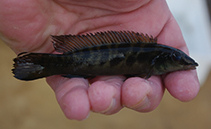Teleocichla preta Varella, Zuanon, Kullander & López-Fernández, 2016
Upload your photos and videos
Pictures | Google imageTeleocichla preta
Picture by Petersen, P.
Pictures | Google imageTeleocichla preta
Picture by Petersen, P.
Common names from other countries
Classification / Names Populärnamn | synonymer | Catalog of Fishes(Släkte, Arter) | ITIS | CoL | WoRMS | Cloffa
> Cichliformes (Cichlids, convict blennies) > Cichlidae (Cichlids) > Cichlinae
Etymology: Teleocichla: Greek, tele, telos = perfect + Greek, kichle = wrasse (Ref. 45335); preta: Adjective in Portuguese meaning black; refers to the diagnostic dark overall colouration of the body and to the previous denominations for the species in the scientific and aquarium literature, as well as among fishermen of the Rio Xingu. Noun in apposition.
Etymology: Teleocichla: Greek, tele, telos = perfect + Greek, kichle = wrasse (Ref. 45335); preta: Adjective in Portuguese meaning black; refers to the diagnostic dark overall colouration of the body and to the previous denominations for the species in the scientific and aquarium literature, as well as among fishermen of the Rio Xingu. Noun in apposition.
Environment: milieu / climate zone / depth range / distribution range Ekologi
; sötvatten bentopelagisk. Tropical; 0°S - 10°S, 55°W - 50°W (Ref. 108975)
Utbredning Länder | FAO områden | Ekosystem | Förekomster | Point map | Utplanteringar | Faunafri
South America: Brazil, Amazon basin, Rios Xingu and Iriri (Ref. 108975).
Size / Vikt / Age
Maturity: Lm ? range ? - ? cm
Max length : 24.5 cm TL hane/ej könsbestämd; (Ref. 126097); publicerad maxvikt: 178.00 g (Ref. 126097)
Max length : 24.5 cm TL hane/ej könsbestämd; (Ref. 126097); publicerad maxvikt: 178.00 g (Ref. 126097)
Short description Bestämningsnycklar | Morfologi | Morfometri
Taggstrålar i ryggfenan (totalt) : 21 - 23; Mjukstrålar i ryggfenan (totalt) : 7 - 10; Taggstrålar i analfenan: 3; Mjukstrålar i analfenan: 8 - 9; Ryggkotor: 35 - 37. This species is distinguished from all its congeners by the following characters: a unique blackish (in live specimens) or dark brown (preserved specimens) general body colouration, which masks the faint vertical bars or a zig-zag pattern of blotches on the flanks; a deeper and posteriorly strongly compressed caudal peduncle, its depth 11.7-14.9 % SL, mean 13% (vs. < 10.9% SL); a deeper body, its depth 17.9-21.6% SL, mean 19.9% (vs. less or equal to 18.3%); stout lower pharyngeal tooth plate bearing molariform teeth on its median area (vs. conical); with maximum size 12.13 cm SL (vs. 8.15 cm SL in the largest known specimen of prionogenys and 8.78 cm SL in wajapi); differs from centrarchus and wajapi by having 3 anal-fin spines (vs. 4); differs from monogramma and centisquama by having the anterior and posterior branches of the lateral line separated by 2 horizontal scale rows (vs. lateral line continuous); differs from gephyrogramma by the absence of a caudal-fin blotch (vs. present, rounded and conspicuous); differs from cinderella by the absence of small dark spots scattered on flanks (vs. presence at least in specimens up to 6.0 cm SL) and by the absence of filamentous dorsal-fin prolongation in sexually dimorphic males (Ref. 108975).
In moderate to fast, shallow rapids, with clear water and the riverbed composed mainly of large rocks and little accumulated sediment. Feeds predominantly on of caddisfly larvae (Trichoptera) and other hard-shelled invertebrates (gastropods and bivalves), as well as midges (Diptera: Chironomidae) and mayfly larvae (Ephemeroptera) (Ref. 108975).
Life cycle and mating behavior Könsmognad | Reproduktion | Lek | Ägg | Fecundity | Larver
Main reference
Upload your references | referenser | Koordinator : Kullander, Sven O. | Medarbetare
Varella, H.R., J. Zuanon, S.O. Kullander and H. López-Fernández, 2016. Teleocichla preta, a new species of cichlid from the Rio Xingu basin in Brazil (Teleostei: Cichlidae). J. Fish Biol. 89(3):1551-1569. (Ref. 108975)
Threat to humans
Harmless
Human uses
FAO(Publication : search) | FishSource |
Ytterligare information
Trophic ecology
Födoslag
Födosammansättning
Födointag
Food rations
Predatorer
Födoslag
Födosammansättning
Födointag
Food rations
Predatorer
Ecology
Ekologi
Home ranges
Ekologi
Home ranges
Population dynamics
Tillväxtparametrar
Max. ages / sizes
Length-weight rel.
Length-length rel.
Length-frequencies
Mass conversion
Rekrytering
Abundans
Tillväxtparametrar
Max. ages / sizes
Length-weight rel.
Length-length rel.
Length-frequencies
Mass conversion
Rekrytering
Abundans
Life cycle
Reproduktion
Könsmognad
Fecundity
Lek
Spawning aggregations
Ägg
Egg development
Larver
Larvdynamik
Reproduktion
Könsmognad
Fecundity
Lek
Spawning aggregations
Ägg
Egg development
Larver
Larvdynamik
Anatomy
Gälyta
Brain
Otolith
Gälyta
Brain
Otolith
Physiology
Body composition
Nutrients
Syreförbrukning
Swimming type
Simhastighet
Visual pigments
Fish sound
Diseases & Parasites
Toxicity (LC50s)
Body composition
Nutrients
Syreförbrukning
Swimming type
Simhastighet
Visual pigments
Fish sound
Diseases & Parasites
Toxicity (LC50s)
Genetics
Genetik
Heterozygosity
Ärftlighet
Genetik
Heterozygosity
Ärftlighet
Human related
Aquaculture systems
Vattenbruksprofiler
Avelslinjer
Ciguatera cases
Stamps, coins, misc.
Aquaculture systems
Vattenbruksprofiler
Avelslinjer
Ciguatera cases
Stamps, coins, misc.
Verktyg
E-book | Fälthandbok | Längdfördelnings-verktyg | Livshistorie-verktyg | Prickkarta | Classification Tree
| Catch-MSY |
Special reports
Download XML
Internet-källor
Aquatic Commons | BHL | Cloffa | Websites from users | Check FishWatcher | CISTI | Catalog of Fishes(Släkte, Arter) | DiscoverLife | ECOTOX | Faunafri | Fishtrace | GenBank(genome, nucleotide) | GloBI | GOBASE | | Google Books | Google Scholar | Google | IGFA World Record | MitoFish | Otolith Atlas of Taiwan Fishes | PubMed | Reef Life Survey | Scirus | SeaLifeBase | Tree of Life | Wikipedia(Go, sök) | World Records Freshwater Fishing | Zoobank | Zoological Record
Estimates based on models
Phylogenetic diversity index (Ref. 82804): PD50 = No PD50 data [Uniqueness, from 0.5 = low to 2.0 = high].
Bayesian length-weight: a=0.00813 (0.00432 - 0.01529), b=3.10 (2.94 - 3.26), in cm Total Length, based on LWR estimates for this species & (Sub)family-body (Ref. 93245).
Trofisk nivå (Ref. 69278): 3.3 ±0.7 se; based on size and trophs of closest relatives
Resiliens (Ref. 120179): Hög, lägsta populationsfördubblingstid mindre än 15 månader (Preliminary K or Fecundity.).
Fishing Vulnerability (Ref. 59153): Low vulnerability (15 of 100).




